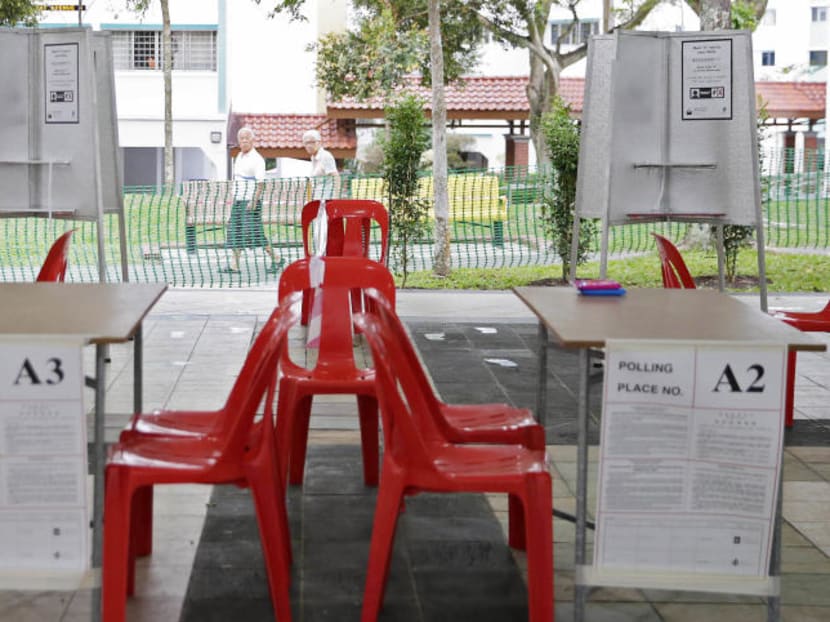Explainer: Who’s on the Electoral Boundaries Review Committee and how it draws up the GE battle lines
SINGAPORE — With the formation of the Electoral Boundaries Review Committee (EBRC) last month, the work is now cut out for the five-member panel of senior civil servants to draw up the battle lines for the next General Election.

The Electoral Boundaries Review Committee will recommend how the map of electoral divisions will look like for the next General Election and the number of parliamentary seats in each constituency.
SINGAPORE — With the formation of the Electoral Boundaries Review Committee (EBRC) last month, the work is now cut out for the five-member panel of senior civil servants to draw up the battle lines for the next General Election.
Appointed by Prime Minister Lee Hsien Loong, the panel is chaired by Mr Lee’s secretary Tan Kee Yong, and comprises Housing and Development Board chief executive Cheong Koon Hean, Singapore Land Authority chief executive Tan Boon Khai, chief statistician Wong Wee Kim and Elections Department (ELD) head Koh Siong Ling, the ELD told TODAY.
ELD said in a press release on Wednesday (Sept 4) that the EBRC is “in the midst of its deliberations”.
Once the committee has completed its review, it will submit a report to the Prime Minister. After this, it could take days or weeks before the GE is triggered with the dissolution of Parliament and the issuance of the writ of election.
In its report, the EBRC will recommend how the map of electoral divisions will look like for the next GE and the number of parliamentary seats in each constituency.
How the committee decides on these will depend on the size and residential distribution of the electorate, as well as the current configuration of the Group Representation Constituencies (GRCs) and Single Member Constituencies (SMCs).
It also depends on Mr Lee’s instruction to the EBRC — for this new committee, he wants it to reduce the size of GRCs and increase the number of SMCs.
POPULATION TRENDS
There are nearly 2.6 million people who are able to vote in the GE, an increase of around 80,000 from 2017, based on the latest update to the voter rolls. It is also more than in previous GEs.
In its past deliberations, the EBRC had raised the number of parliamentary seats based on the total size of the electorate — there were 84 seats in 2006, 87 in 2011, and 89 in 2015.
In 2015, the EBRC determined that one MP could represent between 20,000 and 37,000 voters. It also had to be mindful that the GRCs with fewer MPs should not have more electors than a GRC with more MPs.
Based on the ratio of the number of electors to the number of MPs in the last three GEs, a back-of-the-envelope calculation shows that it is possible more than 93 parliamentary seats could be contested in the upcoming election based on the latest Register of Electors.
| 2006 | 2011 | 2015 | 2019 | |
| Number of electors | 2,157,840 | 2,349,091 | 2,460,977 | 2,594,740 |
| Number of MPs | 84 | 87 | 89 | >93 (extrapolated) |
Source: Elections Department, TODAY
SHRINKING GRC SIZES
But to determine what needs to change based on demographic alone is not enough, as the EBRC has to consider the terms of reference handed to it by the Prime Minister each time it convenes.
Since 2006, the EBRC had been increasingly tasked to reduce the average number of seats per GRC and increase the number of SMCs.
TERMS OF REFERENCE GIVEN TO THE EBRC
| 2006 | 2011 | 2016 |
| Minimum of 8 SMCs as prescribed by the Parliamentary Elections Act | Average size of GRC less than or equal to 5 | Average size of GRC less than 5 |
| Fewer 6-member GRCs | Minimum of 12 SMCs | |
| Minimum of 12 SMCs |
Source: National Archives of Singapore, Elections Department
This has led to changes in the number of GRCs and SMCs over successive general elections as well as reductions in the average size of the GRCs. In 2006, there were 23 constituencies altogether, including nine SMCs and five six-member GRCs. By 2015, there were 29 constituencies — 13 SMCs and two six-member GRCs.
| Number of constituencies |
Number of GRCs |
Number of 6-member GRCs |
Number of SMCs |
Average number of parliamentary seats per GRC | Average number of parliamentary seats per constituency | |
| GE2006 | 23 | 14 | 5 | 9 | 5.36 | 3.65 |
| GE2011 | 27 | 15 | 2 | 12 | 5 | 3.22 |
| GE2015 | 29 | 16 | 2 | 13 | 4.75 | 3.07 |
Source: National Archives of Singapore, Elections Department, TODAY
In its statement on Wednesday, ELD said that the new EBRC will “further reduce the average size of the GRCs and to have more than the current 13 SMCs”.
Describing the changes as “incremental adjustments”, Singapore Management University law professor Eugene Tan told TODAY that with the current average size of a GRC at 4.75, the number could go down to 4.5 and there could be up to 14 or 15 SMCs in the latest review exercise.
Introduced in 1988, the GRC system is designed to ensure minority representation in Parliament, and encourage political parties to be multi-racial in their approach since they have to field Indian and Malay candidates to contest in a GRC and appeal to all races.
The move to reduce the size of GRCs and introduce more SMCs was explained by Mr Lee in Parliament in 2016.
He stated that there was a need for smaller GRCs in order to create a closer connection between MPs and their residents, and for more SMCs which will give MPs direct responsibility over everything that happens in his or her ward.
If they play racial politics during elections, votes that they win from one group will be at the expense of votes lost from another group, he said.
KEEPING CONSISTENCY
As the EBRC tweaks the boundaries to accommodate smaller GRCs, another likely factor for consideration is the need to be consistent across successive elections, which remains a hotly debated topic.
In its report in 2015, the EBRC stated that it took into account “the current configurations” of electoral divisions since the last boundary delineation exercise.
Where voters live matters as well, since people may move homes between election cycles and affect the number of electors in each polling district. Housing development, too, can result in large changes to the electorate count, hence requiring boundaries to be redrawn or the number of MPs per constituency to be changed to better reflect the ratio of MP to elector.
Since the previous GE in 2015, around 90,000 HDB units have been completed, based on TODAY’s estimates of their completion dates of around four to five years of past Build-to-Order sales exercises.
Assoc Prof Tan noted that the EBRC has generally kept electoral boundaries of opposition wards relatively untouched.
“Think Potong Pasir and Hougang, or even Aljunied in 2015,” he said. The two SMCs which were held by the Opposition in 2011 did not see any change to their boundaries in 2015, though there were some changes in the composition of polling districts for Aljunied GRC that year.
Even with the move to shrink GRCs sizes, it is “highly unlikely” that constituencies like Aljunied would get split up in the current review, said Assoc Prof Tan.
The former Nominated MP, in calling for more transparency about the EBRC’s methodology, had pointed out in Parliament in 2013 that the 2011 EBRC had abolished five SMCs, but retained Potong Pasir and Hougang.
“Not surprisingly, accusations of gerrymandering were raised. This takes away from the good work done by the EBRC,” he said then. “The EBRC report sought to advance the principle of fair and balanced representation. The EBRC also sought to ensure that the number of electors in similar-sized GRCs did not suffer from too much variation among them.”
COMPOSITION OF THE EBRC
The five-member panel has continued to be chaired by the Cabinet secretary, with the head of the ELD acting as the EBRC’s secretary. Its other three members have included the chief statistician and the heads of HDB and SLA. ELD officers assist the EBRC by doing its legwork.
The members typically change when a person leaves his civil service position. The only new individual in the current EBRC is Mr Koh Siong Ling, who replaced Mr Lee Seng Lup when he retired from the ELD after 2015.
Membership into the EBRC itself, which has consisted of civil servants for many years, has also been debated previously, with some calling for political parties to be a part of the boundary delineation process.
Former Workers’ Party Non-Constituency MP Yee Jenn Jong suggested this in 2015, as well as to bring in outside expertise into the EBRC. Prime Minister Lee Hsien Loong replied that he would consider the suggestion on outside expertise, but not on having political parties’ involvement.
He said: “(The EBRC) has for many years comprised civil servants who have domain knowledge which enables them to make considered decisions on how to divide up the constituencies — taking into account, as I have said, population shifts, housing developments, and also how to do this in a practical sort of way, so that we do not have complete upheaval each time there is redemarcation.”
Allowing political parties to participate, as how it is done in the United States by the sitting members of the House of Representatives, would end up with politicians deciding “to carve it up among themselves”, he added. “It is a political deal and I think that’s not a good arrangement and it’s best we leave this to the civil servants to work at.”








